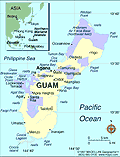Guam | Facts & Information

- Guam Profile
Facts & Figures
-
TERRITORY OF GUAM
Status: Territory
Governor: Felix Camacho (2003)
Capital (2000 est.): Agaña, 1,100
Land area: 212 sq mi (549 sq km)
Population (2008 est.): 175,877 (growth rate: 1.3%); birth rate: 18.3/1000; infant mortality rate: 6.5/1000; life expectancy: 78.9; density per sq mi: 325. 1996 est. net migration: 3 migrants per 1,000 population
Languages: English and Chamorro; note: most residents are bilingual; Japanese also widely spoken
Ethnicity/race: Chamorro 37%, Filipino 26%, Caucasian 10%, Chinese, Japanese, Korean, and other, 27%
Religions: Roman Catholic 85%, other 15% (1999 est.)
National Holiday: Discovery Day, 1st Monday in March
Literacy rate: 99% (1990 est.)
Monetary unit: U.S. dollar
Economic summary: GDP/PPP (2005 est.): $2.5 billion; per capita $15,000. Real growth rate: n.a. Inflation: 2.5%. Unemployment: 11.4% (2002 est.). Arable land: 9%. Agriculture: fruits, copra, vegetables; eggs, pork, poultry, beef. Labor force: 60,000 (2000 est.); federal and territorial government 26%, private 74% (trade 24%, other services 40%, industry 10%) (2000 est.). Industries: U.S. military, tourism, construction, transshipment services, concrete products, printing and publishing, food processing, textiles. Natural resources: fishing (largely undeveloped), tourism (especially from Japan). Exports: $3.94 billion f.o.b. (2005 est.): mostly transshipments of refined petroleum products; construction materials, fish, food and beverage products. Imports: $701 million f.o.b. (2004 est.): petroleum and petroleum products, food, manufactured goods. Major trading partners: Japan, South Korea, Singapore, Hong Kong, Philippines (2004).
Communications: Telephones: main lines in use: 84,134 (1998); mobile cellular: 55,000 (1998). Radio broadcast stations: AM 4, FM 7, shortwave 2 (2003). Radios: 221,000 (1997). Television broadcast stations: 5 (1997). Televisions: 106,000 (1997). Internet Service Providers (ISPs): 20 (2000). Internet users: 5,000 (2001).
Transportation: Railways: 0 km. Highways: total: 885 km; paved: 675 km; unpaved: 210 km note: there is another 685 km of roads classified non-public, including roads located on federal government installations. Ports and harbors: Apra Harbor. Airports: 5 (2002).
International disputes: none.








